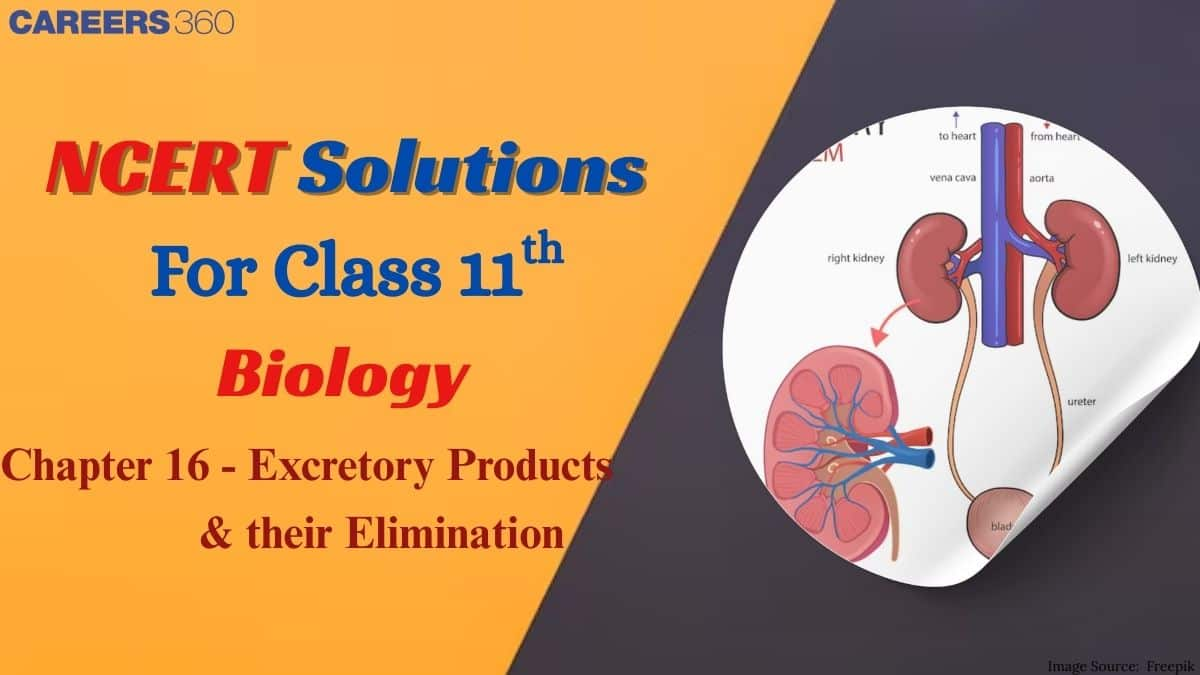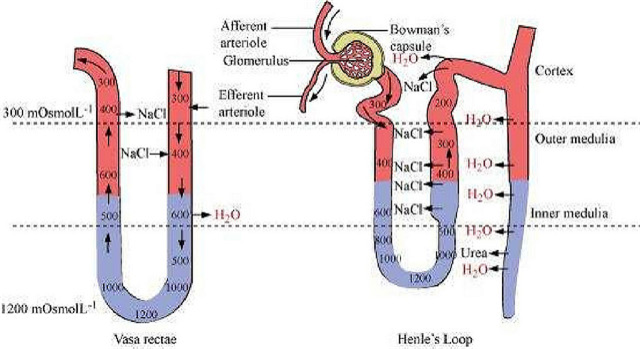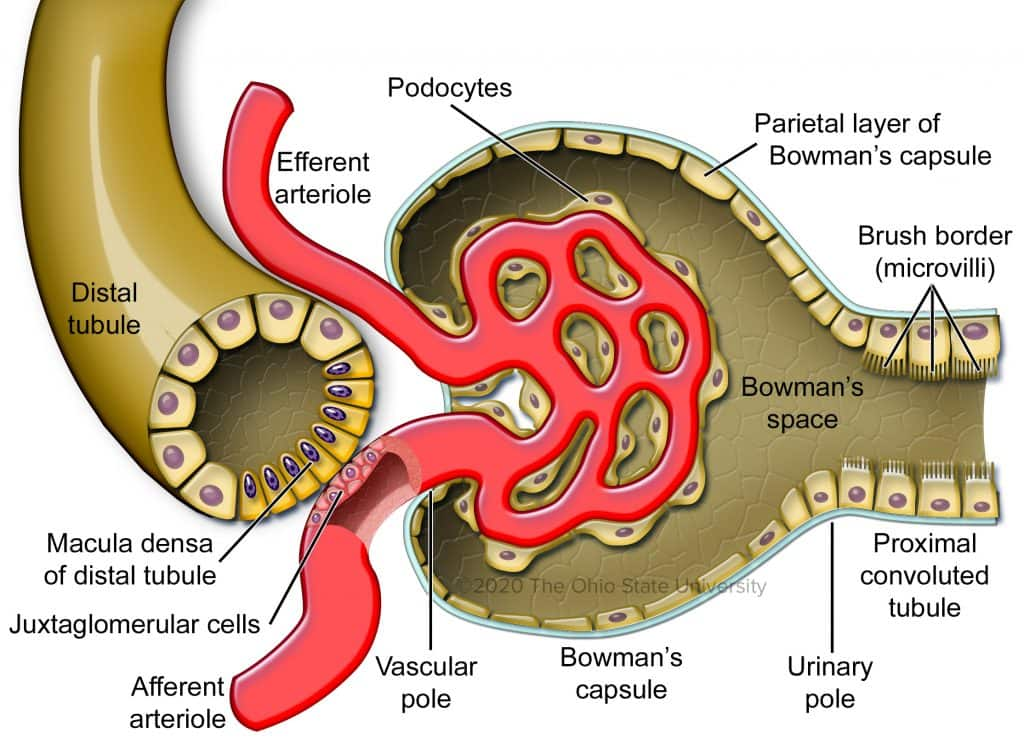The NCERT Solutions for Class 11 Biology Chapter 16 Excretory Products and Their Elimination explain how the body eliminates waste products. The chapter deals with concepts like the formation of urine, the structure of renal tubules, and disorders of the excretory system. It is an important chapter for board exams and competitive exams such as NEET. The NCERT Solutions provide a detailed explanation to help students learn and master the subject without any confusion.
This Story also Contains
- Download Excretory Products and Their Elimination Class 11 Questions and Answers PDF
- Get Class 11 Biology Chapter 16 Excretory Products and Their Elimination Question Answer
- Approach to Solve Excretory Products and Their Elimination Class 11 Question Answer
- Important Questions of NCERT Class 11 Biology Chapter 16 Excretory Products and Their Elimination
- What Students Learn from Excretory Products and Their Elimination NCERT Solutions?
- Why Chapter 16 Excretory Products and Their Elimination NCERT Solutions are Important?
- What Extra Should Students Study Beyond the NCERT for NEET?
- NCERT Solutions for Class 11 Biology - Chapter Wise
 NCERT Solutions for Class 11 Biology Chapter 16 Excretory Products and Their Elimination
NCERT Solutions for Class 11 Biology Chapter 16 Excretory Products and Their Elimination
Excretory Products and Their Elimination Class 11 question answer explains how the body eliminates waste using organs such as the kidneys, liver, and skin. The Excretory Products and Their Elimination Class 11 Questions and Answers PDF also discusses how toxic substances are eliminated to maintain the body in a healthy state. The NCERT Solutions for Class 11 are prepared in simple language by the subject experts and include practice questions to help students prepare well for exams.
Download Excretory Products and Their Elimination Class 11 Questions and Answers PDF
Studying through a PDF makes learning more organized and systematic. The Excretory Products and Their Elimination Class 11 Questions and Answers PDF can be accessed offline for easy and quick revision anytime. It also helps students practice questions in a structured manner.Download PDF
Get Class 11 Biology Chapter 16 Excretory Products and Their Elimination Question Answer
The complete exercise and in-text answers are given below. Studying through the Class 11 Biology Chapter 16 Excretory Products and Their Elimination question answer helps students revise important concepts. These solutions are based on the latest NCERT curriculum and help in quick revision before exams.
Q1. Define Glomerular Filtration Rate (GFR)
Answer: The Glomerular Filtration Rate (GFR) is a measure of how well the kidneys filter the blood.
- GFR is the rate of fluid filtered by all of the nephrons in both kidneys per minute.
- Normal GFR in healthy adults is roughly 125 mL/min (180 liters per day).
Q2. Explain the autoregulatory mechanism of GFR.
Answer: The kidneys contain a systematic mechanism to control GFR through the Juxtaglomerular apparatus (JGA).
- The JGA senses reduced GFR and releases renin, activating the renin-angiotensin system to cause vasoconstriction and increase blood pressure.
- This action restores glomerular filtration pressure, bringing GFR back to normal.
Q3. Indicate whether the following statements are true or false:
(a) Micturition is carried out by a reflex.
(b) ADH helps in water elimination, making the urine hypotonic.
(c) Protein-free fluid is filtered from blood plasma into the Bowman’s capsule.
(d) Henle’s loop plays an important role in concentrating the urine.
(e) Glucose is actively reabsorbed in the proximal convoluted tubule.
Answer: The true and false statements are mentioned below:
Statement | True/False |
(a) Micturition is carried out by a reflex. | True |
(b) ADH helps in water elimination, making the urine hypotonic. | False |
(c) Protein-free fluid is filtered from blood plasma into the Bowman’s capsule. | True |
(d) Henle’s loop plays an important role in concentrating the urine. | True |
(e) Glucose is actively reabsorbed in the proximal convoluted tubule. | True |
Q4. Give a brief account of the counter-current mechanism.
Answer: The countercurrent mechanism plays a crucial role in the concentration of urine and water conservation.
- It maintains a medullary osmotic gradient (300 → 1200 mOsm/L).
- The Loop of Henle removes NaCl (ascending limb) while urea recycling from the collecting duct also contributes. The vasa recta preserves this gradient by countercurrent exchange.

Q5. Describe the role of the liver, lungs, and skin in excretion
Answer: Various organs contribute to the excretion processes of the body, each with distinct functions.
| Organ | Role |
|---|
| Liver | Converts ammonia to urea and excretes bile pigments/drugs. |
| Lungs | Remove carbon dioxide through exhalation. |
| Skin | Sweat glands excrete water and salts; sebaceous glands secrete oils. |
Q6. Explain micturition
Answer: Passing urine out of the bladder is called Micturition
- As the urine builds up, bladder stretch initiates a spinal reflex, the urethral sphincters relax, and the muscles of the bladder contract.
- Adults typically urinate approximately 1–1.5 liters per day.
Q7. Match the items of column I with those of column II
Column I Column II
(a) Ammonotelism (i) Birds
(b) Bowman’s capsule (ii) Water reabsorption
(c) Micturition (iii) Bony fish
(d) Uricotelism (iv) Urinary bladder
(e) ADH (v) Renal tubule
Answer: The correct matching is a-iii, b-v, c-iv, d-i, e-ii
Column I | Column II |
(a) Ammonotelism | (iii) Bony fish |
(b) Bowman’s capsule | (v) Renal tubule |
(c) Micturition | (iv) Urinary bladder |
(d) Uricotelism | (i) Birds |
(e) ADH | (ii) Water reabsorption |
Q8. What is meant by the term osmoregulation?
Answer: Osmoregulation is important for the balance of water and salts in body fluids.
- It controls water and ionic content to maintain the internal environment constant.
Q9. Terrestrial animals are generally either ureotelic or uricotelic, not ammonotelic. Why?
Answer: Terrestrial animals primarily excrete urea or uric acid due to ammonia's toxicity and water requirements.
| Excretion Type | Toxicity Level | Water Needed | Example |
|---|
| Ammonotelism | High | High | Fish |
| Ureotelism | Low | Moderate | Mammals |
| Uricotelism | Very low | Minimal | Birds/Reptiles |
Q10. What is the significance of the juxta-glomerular apparatus (JGA) in kidney function?
Answer: The JGA has an important function in the control of kidney function through the monitoring of blood pressure.
- It secretes renin when GFR is low, which stimulates angiotensin II to constrict blood vessels and stimulate the secretion of aldosterone.
- This increases blood pressure and glomerular filtration rate.

Q11. Name the following:
(a) A chordate animal having flame cells as excretory structures
Answer: A chordate animal having flame cells as excretory structures is an Amphioxus.
Q11. Name the following:
(b) Cortical portions projecting between the medullary pyramids in the human kidney
Answer: Cortical portions projecting between the medullary pyramids in the human kidney are called columns of Bertin.
Q11. Name the following:
(c) A loop of capillary running parallel to Henle's loop.
Answer: A loop of capillary running parallel to Henle’s loop is the vasa recta.
Q12. Fill in the gaps :
(a) The ascending limb of Henle’s loop is _______ to water, whereas the descending limb is _______ to it.
(b) Reabsorption of water from the distal parts of the tubules is facilitated by hormone _______.
(c) Dialysis fluid contains all the constituents as in plasma except _______.
(d) A healthy adult human excretes (on average) _______ gm of urea/day.
Answer:
(a) The ascending limb of Henle’s loop is impermeable to water, whereas the descending limb is permeable to it.
(b) Reabsorption of water from the distal parts of the tubules is facilitated by the hormone ADH.
(c) Dialysis fluid contains all the constituents as in plasma except nitrogenous wastes.
(d) A healthy adult human excretes (on average) 20-30 g of urea/day.
NCERT Solutions for Class 11: Subject-wise
Approach to Solve Excretory Products and Their Elimination Class 11 Question Answer
To answer questions from this chapter correctly, Students can follow the simple steps given below:
Start by understanding the different types of nitrogenous wastes. It includes ammonia, urea, and uric acid, and knows which organisms excrete which type.
- Learn the structure and function of the human excretory system, especially the kidneys and nephrons. These are well-explained in the Class 11 Biology Chapter 16 Excretory Products and Their Elimination question answer.
Understand the process of urine formation, and the steps, like filtration, reabsorption, and tubular secretion. Practice diagram-based questions, especially of the nephron and excretory system.
Study from the Class 11 Biology Excretory Products and Their Elimination question answer. Focus on how the kidneys regulate water and salts in the body (osmoregulation).
Revise disorders related to the excretory system, such as kidney stones, uremia, dialysis, and kidney transplantation.
Solve the different questions given in the NCERT Solutions for Class 11 Biology to improve the conceptual clarity.
Also, check the NCERT Books and NCERT Syllabus here :
Important Questions of NCERT Class 11 Biology Chapter 16 Excretory Products and Their Elimination
Take a look at the important questions that can help in increasing the understanding of the concept. To score well in the exam, it is very important to practice many questions of different types. For this purpose, students can depend on the NCERT Solutions for Class 11 Biology Chapter 16 Excretory Products and Their Elimination.
Question 1: Which of the following is not a component of the human excretory system?
i. Kidneys
ii. Ureters
iii. Lungs
iv. Intestines
Options:
i and ii
ii and iii
i and iii
iii and iv
Answer: The correct answer is option (4).
Explanation: Lungs and intestines are not included in the excretory system and are not responsible for expelling nitrogenous wastes such as urea. The urinary system includes the kidneys, ureters, urinary bladder, and urethra, which are responsible for excretion.
Question 2: Which one of the following is also known as an antidiuretic hormone?
Options:
Oxytocin
Vasopressin
Adrenaline
Calcitonin
Answer: The correct answer is option (2).
Explanation: The hypothalamus produces the peptide hormone vasopressin, sometimes referred to as antidiuretic hormone (ADH), which is secreted by the posterior pituitary gland. Its main function is to control blood pressure and the body's water balance.
Question 3: The following substances are the excretory products in animals. Choose the least toxic from among them.
Options:
Urea
Uric acid
Ammonia
Carbon dioxide
Answer: The correct answer is option (2).
Explanation:
Animals that excrete nitrogenous waste as uric acid or its salts as a paste or pellet with little water loss are known as uricotelic animals. The level of toxicity can be shown below, with ammonia being the
most toxic.
Ammonia; Urea; Uric acid
Question 4: Filtration of the blood takes place at
Options:
PCT
DCT
Collecting ducts
Malpighian body
Answer: The correct answer is option (4).
Explanation: The afferent arteriole feeds the glomerulus, a tuft of high-pressure capillaries that supply each nephron. The Bowman's capsule, a continuous, complex tubule with a proximal end that encircles the glomerulus, makes up the remainder of the nephron. The renal corpuscle, also known as the Malpighian body, is made up of the glomerulus and Bowman's capsule. The capillaries create the efferent arteriole, a second arteriole after exiting the renal corpuscle.
Question 5: The pH of human urine is approximately
Options:
6.5
7
6
7.5
Answer: The correct answer is option (3).
Explanation: The pH of human urine is approximately 6.0, making it slightly acidic under normal conditions. However, it can vary between 4.5 and 8.0 depending on factors like diet, hydration, and overall health. Acidic urine may result from a high-protein diet or metabolic acidosis, while alkaline urine can occur with vegetarian diets or urinary tract infections. Monitoring urine pH is useful in diagnosing and managing various medical conditions.
Question 6: The functional unit of the kidney is
Options:
- Nephron
- Glomerulus
- Bowman’s capsule
- Renal pelvis
Answer: The correct answer is option (1).
Explanation: A nephron is the structural and functional unit of the kidney responsible for filtration, reabsorption, secretion, and urine formation. Each human kidney contains about 1–1.5 million nephrons, which together maintain fluid balance and remove metabolic wastes from the body. The nephron includes the renal corpuscle and renal tubules, all of which work together to produce urine efficiently.
Question 7: The counter-current mechanism in the nephron mainly operates between
Options:
- PCT and DCT
- Loop of Henle and vasa recta
- Glomerulus and Bowman’s capsule
- Collecting duct and ureter
Answer: The correct answer is option (2).
Explanation: The counter-current mechanism involves the descending and ascending limbs of the Loop of Henle and the vasa recta running parallel to it. This arrangement helps create a concentration gradient in the medulla, allowing the kidneys to produce concentrated urine with minimal water loss. It is essential for water conservation, especially in mammals living in dry environments.
What Students Learn from Excretory Products and Their Elimination NCERT Solutions?
Students will study how the human body removes nitrogenous wastes and maintains osmotic balance through the excretory system.
They will learn about different types of nitrogenous wastes like ammonia, urea, and uric acid in animals.
Excretory Products and Their Elimination Class 11 question answer explores the process of urine formation and the role of the nephron in filtration, reabsorption, and secretion.
Students understand the structure of the human excretory system, including the kidneys, ureters, urinary bladder, and urethra.
Through the Class 11 Biology Excretory Products and Their Elimination question answer, learners study concepts like osmoregulation and counter-current mechanism.
Why Chapter 16 Excretory Products and Their Elimination NCERT Solutions are Important?
The Excretory Products and their Elimination chapter explains how the human body removes the metabolic wastes. It includes the structure and function of the kidneys, nephron, and other excretory organs, by which students can understand the process of urine formation as well.
- Class 11 Biology Chapter 16 Excretory Products and Their Elimination NCERT Solutions are important becuase they provide detailed and step-by-step explanations of complex topics such as ultrafiltration and reabsorption.
- The solutions also include a well-labeled diagram of the structure of the kidney and the pathway of urine formation.
- Students can easily learn the role of the counter-current mechanism and nitrogenous wastes elimination in different organisms, through the solutions.
- By going through these solutions, students can improve their understanding of the excretory system and prepare well for NEET and other competitive exams.
What Extra Should Students Study Beyond the NCERT for NEET?
Here is a table for all the important topics from the chapter. Students should also focus on diagrams, MCQs, and conceptual questions from books. For more understanding, they can refer to the NCERT Solutions for Class 11 Biology Chapter 16 Excretory Products and Their Elimination, which are explained in easy language.
NCERT Solutions for Class 11 Biology - Chapter Wise
Below are the chapter-wise solutions for quick and easy access:



